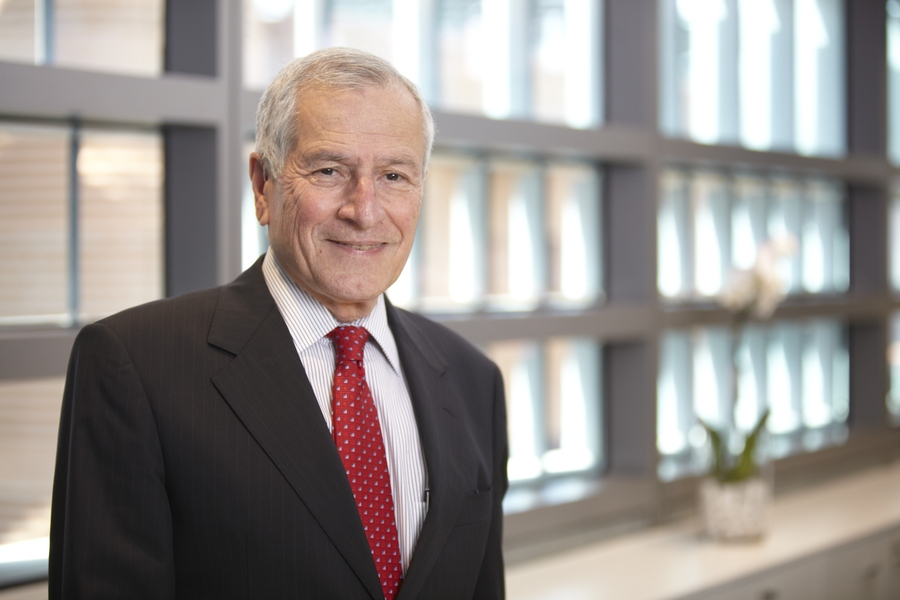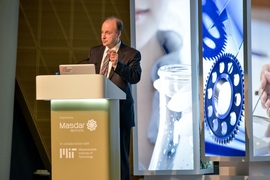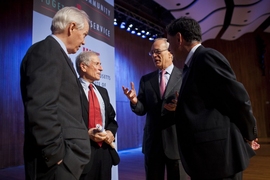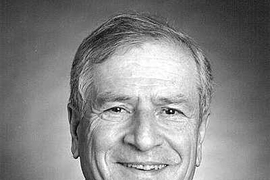Fred Moavenzadeh, the James Mason Crafts Professor of Systems Engineering and Environmental Engineering at MIT, believes in the importance of academic international engagements from the MIT perspective. Further, he subscribes to the view held by MIT President L. Rafael Reif, as stated in the January/February 2011 MIT Faculty Newsletter:
“The world’s great challenges do not have national boundaries. Moreover, even though the U.S. will continue to be a source of inspiration for new ideas in research and education, many creative ideas will emerge or be implemented first elsewhere. Consequently, it is essential to MIT’s continuing strength that our faculty and students remain closely engaged with the increasingly interconnected and expanding world of ideas and innovation.”
Moavenzadeh indicates that one of the things he has most appreciated during his 50-year career at MIT is the Institute’s willingness to allow its faculty and academic leaders to freely pursue mutually beneficial engagements with U.S. and foreign collaborators and sponsors.
As the director of the Technology and Development Program at MIT and former president of the Masdar Institute of Science and Technology (2010-2015), Moavenzadeh explains: “I have always defended the need for educating globally-engaged science and engineering students to succeed in an international research environment. This is precisely what Masdar Institute, with MIT’s help, is doing; and in a very short period of time, Masdar Institute, which was established in 2007, has become known as a regional hub of innovation in the Middle East.”
Moavenzadeh is in agreement with other academic leaders in that the global landscape has changed drastically since World War II and says that “global interdependency and public and private partnerships — that is, working together — are the key to solving the enormous problems facing the world today.”
Evolution from philanthropy to necessity
When Moavenzadeh arrived at MIT as an assistant professor in the summer of 1965, the Institute’s international initiatives in the post-World War II era had been underway for two decades. The war had inspired a wave of global philanthropic and outreach efforts by the United States, and MIT received funding from private foundations and government agencies for foreign projects.
In the 1940s and ’50s, MIT was involved with creating the Aeronautics Institute of Technology in Brazil. The late ’50s and ’60s saw a wave of involvement from leading American universities, including MIT, in the creation of seven Indian Institutes of Technology (IITs) throughout India. In 1952, MIT established the interdisciplinary Center for International Studies, which today still conducts research and teaching in a range of international subjects.
In the ’60s, MIT began working in South America through the MIT Inter-American Program in Civil Engineering, with the goal of developing graduate education programs in science and engineering in Latin American universities. In Moavenzadeh’s early years at MIT, he received a number of grants to work at universities in Venezuela, Argentina, and Colombia.
“These grants provided for faculty and student exchanges and for the development of a number of academic programs that were eventually offered at these universities. It worked very well in my field, to the extent that eventually, in Venezuela, we decided to put together a summer program in transportation.”
The International Nutrition Program developed by Nevin Scrimshaw led to the establishment of the International Nutrition Foundation in 1982 to mobilize support for training, research, communication and policy related to food and nutrition in developing countries. In the ’70s and ’80s, MIT worked with Cairo University in Egypt to establish the Development Research and Technological Planning Center, which is still operational today.
Jack Ruina, then a professor of engineering at MIT, organized a program geared towards adapting technologies to conditions in developing countries; that project would later become the MIT Technology and Development Program (TDP), which Moavenzadeh has directed since 1973.
Moavenzadeh also worked in East Africa — primarily in Ethiopia, with some work in Kenya, Tanzania, and Malawi — on their transport systems.
Moavenzadeh says, “Within the newly industrialized world, science and technology were once considered a luxury. This is no longer the case. The establishment of an advanced research-based science and technology infrastructure is now a critical component in the economic development of any nation.”
In close cooperation with local academic institutions, governmental organizations, and industry, TDP under the directorship of Moavenzadeh has forged relationships that enable graduate level, research-based science and technology centers of learning, developed and shaped by the human capacity from within the culture they serve. The process has been complex, and dependent on circumstances in each country.
Moavenzadeh says, “We shared our knowledge, providing guidance and assistance in the scholarly assessment of curriculum and top tier faculty. TDP set a level of quality control in the establishment of these intellectual centers that ensured the development stream essential for the critical thinking necessary for these endeavors. Our organization was lean and agile, flexible to the independent situations and university relationships we cultivated.”
He further states, “As we all know, a university cannot stand alone. It is for this reason that TDP has always endeavored to create an atmosphere of understanding and solutions-based guidance within the existing academic and cultural infrastructure of newly industrialized states. These are countries faced with both practical and intellectual challenges that require real-world structural answers. We worked to foster the creation of communities determined to answer the questions these countries face, in an atmosphere of academic, industrial, and governmental cooperation.”
Initial forays into Latin America led to the introduction of structural changes enabling a rural electricity system in Colombia. In East Africa, TDP's work — in training and establishing local manpower with the Ethiopian Transportation Department — allowed a country divided by geography to meet. “For example, food production in Ethiopia was sufficient to support the population,” Moavenzadeh explains. “But the problem was transportation and how to get the food to the people who needed it. So the issue was not food production; it was building transport systems.”
Benefits from international collaborations
If MIT’s international engagements were initially driven from philanthropic sensibility and the desire to do something good, in Moavenzadeh’s view, they have evolved into one of mutual benefit. Over the decades, as MIT faculty, staff, and students took part in projects from Brazil to Lebanon to Japan to Thailand, the purpose and nature of the collaborations shifted.
Moavenzadeh agrees with the MIT International Advisory Committee report citing the following benefits from engaging in these international activities:
- High-quality opportunities for MIT students and faculty to learn about and engage with the world;
- Unique and enhanced research opportunities for MIT students and faculty; and
- International service activities that build on MIT's strengths and leadership, while providing new research and educational opportunities for our own faculty, students, and staff.
Lessons learned
International collaboration has become integral to higher education in the 21st century. MIT is well known, as is its commitment to research and curricular activities anchored in a global context.
Moavenzadeh says, “There are always risks and challenges in anything worth doing.”
Over the years, Moavenzadeh says, he has learned that the most successful engagement platforms are those built on consensus, trust, and respect. If there’s one thing Moavenzadeh has learned working with people across every continent, it’s that there’s more than one way to accomplish a goal — and that cultural understanding is paramount.
“If they don't do it your way, it doesn't mean that they won't do it. You have to look at the output,” says Moavenzadeh. “It's not my way or no way; but rather let's find a way and work together.
“From Egypt to Malaysia to Abu Dhabi, we have learned much. We know a cooperative program has to have a critical mass. One or two small projects cannot facilitate change. Every element — academia, government, industry — must participate and share a common goal. Our projects demand a 'champion' from the country they serve; a person or a team from local government, industry, or academia. One who will act as a strong facilitator, a visionary, and a partner and continue to support and encourage the project long after our participation is needed.
“Successful work requires a multi-year commitment, in order to build and develop the infrastructure to ensure our work will sustain — and a commitment of adequate resources from the participating countries and universities. In addition, non-financial incentives must be offered to accomplish our tasks. The promise of a compelling intellectual challenge — and academic support — for the students involved is necessary to create an atmosphere of collaboration, curiosity, and scholarship essential to solve problems. To accomplish this, all parties involved must remain committed to the vision of the project, and its long-term objectives.”
A look at the creation of Masdar Institute — a university from sand
MIT’s international engagements have spanned not only different cultures, but countries with vastly different resources. In 2007 Moavenzadeh began working in the United Arab Emirates (UAE), where he encountered a situation distinct from those he had seen in the past.
“The countries that I often worked in were short in capital, but rich in manpower,” Moavenzadeh says. “The question was, how do you use that limited capital to create employment? So job creation was the major concern: labor-intensive technologies. But in the UAE, it's the reverse. There is an abundance of capital, but shortage of manpower. So how do you use that limited manpower productively in that society?”
The solution that the UAE pursued was to increase and improve science, technology, and management education, in order to support a knowledge-based economy. That solution took the form of a brand new university — Masdar Institute — to be built in a planned city in Abu Dhabi, the UAE capital.
The government of the UAE approached MIT in the summer of 2005 for help in establishing a not-for-profit, graduate-level research-based university. In the fall of 2007, the university was established, and in 2010, Moavenzadeh was appointed president of the Masdar Institute, a position he held until July 31, when he retired.
Moavenzadeh says, “Thanks in part to the lessons learned over decades of experience in numerous countries, Masdar Institute is growing steadily. It has graduated nearly 400 students and employs nearly 100 faculty, many of whom are taking part in research collaborations not only with MIT but with other public and private sector entities.”
In conclusion, Moavenzadeh says, “Culturally, socially, and technologically, we had surprises — but nothing big enough to stop the development of the program, so we must be doing something right.”









